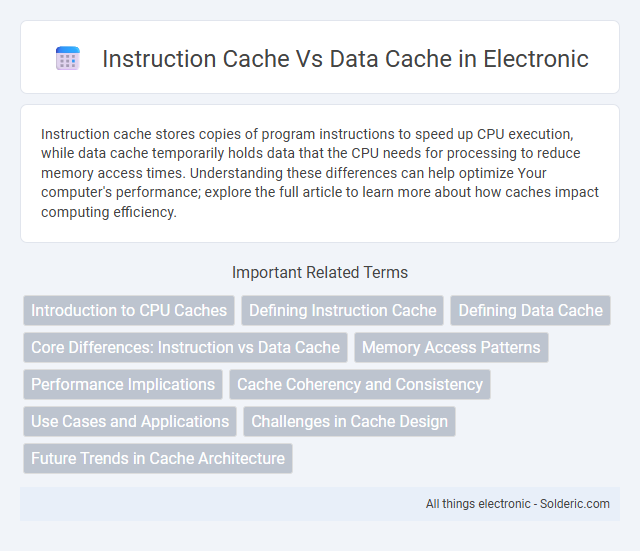Instruction cache stores copies of program instructions to speed up CPU execution, while data cache temporarily holds data that the CPU needs for processing to reduce memory access times. Understanding these differences can help optimize Your computer's performance; explore the full article to learn more about how caches impact computing efficiency.
Comparison Table
| Feature | Instruction Cache | Data Cache |
|---|---|---|
| Purpose | Stores CPU instructions | Stores CPU data |
| Stored Content | Program instructions | Operands and variables |
| Access Type | Read-only | Read and write |
| Cache Miss Impact | Delays instruction fetch | Delays data access |
| Size | Usually smaller | Typically larger |
| Optimization Focus | Fast sequential access | Efficient random access |
| Examples | Level 1 Instruction Cache (L1i) | Level 1 Data Cache (L1d) |
Introduction to CPU Caches
CPU caches improve processing speed by storing frequently accessed data closer to the processor. The instruction cache specifically holds executable instructions, enabling the CPU to fetch commands rapidly, while the data cache stores operands and results for ongoing computations. Understanding the distinction between instruction cache and data cache is crucial for optimizing your system's performance and reducing latency during program execution.
Defining Instruction Cache
Instruction cache is a specialized CPU cache that stores executable code instructions to expedite the fetch phase during instruction processing. It improves processor efficiency by reducing the latency in accessing instructions from main memory, enhancing overall system performance. Unlike data cache, which holds data operands, instruction cache is optimized specifically for sequential instruction access patterns.
Defining Data Cache
Data cache is a specialized memory designed to store and quickly retrieve data that a processor frequently accesses, reducing latency and improving overall system performance. Unlike instruction cache, which stores executable code, data cache holds variables, operands, and other runtime data essential for processing tasks. Understanding how your system manages data cache can optimize memory access patterns and enhance computing efficiency.
Core Differences: Instruction vs Data Cache
Instruction cache stores executable code, enabling faster retrieval of program instructions, while data cache holds actual data values needed during execution. The instruction cache is typically read-only and optimized for sequential access patterns, whereas data cache supports both read and write operations with more complex access patterns. Understanding these core differences helps optimize your system's processor performance by improving instruction fetch and data access efficiency.
Memory Access Patterns
Instruction cache and data cache serve different memory access patterns crucial for optimizing CPU performance. Instruction cache primarily handles sequential memory access to fetch program instructions, benefiting from predictable, linear access patterns. Data cache, however, manages irregular and unpredictable access patterns caused by dynamic data usage, requiring optimization for spatial and temporal locality to reduce latency and improve throughput.
Performance Implications
Instruction cache stores executable code, enabling faster fetch cycles and reducing CPU stall times, while data cache stores runtime data, improving load and store operations. A well-optimized instruction cache minimizes pipeline bottlenecks, and an efficient data cache accelerates memory access, both crucial for maximizing CPU performance. Your system's overall efficiency depends on the balance and size of these caches to reduce latency and improve throughput.
Cache Coherency and Consistency
Instruction cache and data cache manage cache coherency and consistency differently due to their distinct roles in a processor. Instruction caches primarily ensure coherency by fetching immutable code, reducing the need for frequent updates, while data caches require strict consistency mechanisms to handle read/write operations and synchronization between cores. Your system's performance and reliability depend on maintaining these protocols to prevent stale or corrupted data from affecting execution.
Use Cases and Applications
Instruction cache is optimized for storing processor instructions, enhancing CPU performance in executing sequential code patterns typical in applications like operating systems, gaming, and embedded systems. Data cache stores data frequently accessed by the CPU, improving efficiency in workloads such as database processing, scientific computing, and real-time analytics. Both caches are crucial in high-performance computing environments, balancing instruction fetch speed and data retrieval to reduce latency and increase throughput.
Challenges in Cache Design
Instruction cache and data cache face distinct challenges in cache design, including balancing latency and hit rate to optimize processor performance. Managing cache coherence and avoiding conflicts between instruction fetches and data accesses require sophisticated algorithms and hardware mechanisms. Your system's efficiency depends on minimizing cache misses and ensuring rapid access to both instructions and data to maintain smooth computational workflows.
Future Trends in Cache Architecture
Future trends in cache architecture emphasize the integration of unified caches that dynamically allocate resources between instruction and data caching to enhance performance and reduce latency. Advances in machine learning algorithms are being employed to predict access patterns, optimizing instruction and data cache prefetching for your device's specific workload. Energy-efficient designs, such as non-volatile memory technologies, are also emerging to minimize power consumption while maintaining high-speed access for both instruction and data caches.
instruction cache vs data cache Infographic

 solderic.com
solderic.com